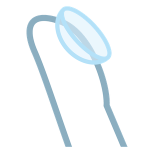【A】日本においては小児におけるセレコックスの安全性は確立していない。アメリカにおいては、体重が25kg以上であれば1回100mgを1日2回で使用可能とされている。小児に対するセレコックスの使用は以下の詳細を参考に施設の医療担当者の裁量と判断となる。
アメリカの添付文書によると若年性関節リウマチの疾患において、小児患者(2歳以上)で使用可能である。
10kg以上25kg未満の場合、推奨用量は1日2回 (1回50mg)。
25kgを超える患者の場合、推奨用量は1日2回 (1回100mg)
小児等への投与
低出生体重児、新生児、乳児、幼児、小児に対する安全性は確立していない。(使用経験がない。)
(引用 : セレコックス錠 添付文書 第7版)
DOSAGE AND ADMINISTRATION
For the relief of the signs and symptoms of JRA the recommended oral dose for pediatric patients (age 2 years and older) is based on weight. For patients≥10 kg to <25 kg the recommended dose is 50 mg twice daily. For patients >25 kg the recommended dose is 100 mg twice daily.
Pediatric Use
Celecoxib is approved for relief of the signs and symptoms of Juvenile Rheumatoid Arthritis in patients 2 years and older. Safety and efficacy have not been studied beyond six months in children. The long-term cardiovascular toxicity in children exposed to celecoxib has not been
evaluated and it is unknown if long-term risks may be similar to that seen in adults exposed to celecoxib or other COX-2 selective and non-selective NSAIDs [see Boxed Warning, Warnings and Precautions (5.12), and Clinical Studies (14.3)]. The use of celecoxib in patients 2 years to 17 years of age with pauciarticular, polyarticular course JRA or in patients with systemic onset JRA was studied in a 12-week, double-blind,
active controlled, pharmacokinetic, safety and efficacy study, with a 12-week open-label extension. Celecoxib has not been studied in patients under the age of 2 years, in patients with body weight less than 10 kg (22 lbs), and in patients with active systemic features. Patients
with systemic onset JRA (without active systemic features) appear to be at risk for the development of abnormal coagulation laboratory tests. In some patients with systemic onset JRA, both celecoxib and naproxen were associated with mild prolongation of activated partial
thromboplastin time (APTT) but not prothrombin time (PT). NSAIDs including celecoxib should be used only with caution in patients with systemic onset JRA, due to the risk of disseminated intravascular coagulation. Patients with systemic onset JRA should be monitored for the development of abnormal coagulation tests [see Dosage and Administration (2.3), Warnings and Precautions (5.12), Adverse Reactions (6.3), Animal Toxicology (13.2), Clinical Studies (14.3)]. Alternative therapies for treatment of JRA should be considered in pediatric patients identified to be CYP2C9 poor metabolizers [see Poor Metabolizers of CYP2C9 substrates (8.8)].(CELECOXIB 100 MG- celecoxib capsule 米国添付文書)




























